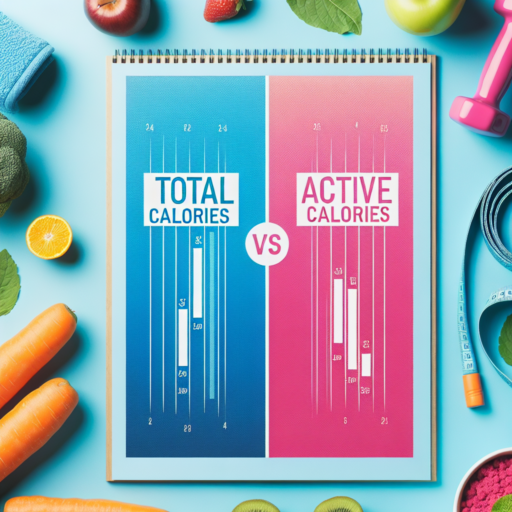Understanding Total vs Active Calories: The Essentials
In the realm of health and fitness, distinguishing between total calories and active calories is vital for anyone looking to manage their weight effectively or improve their overall athletic performance. Total calories encompass the entirety of calories burned throughout the day, including during periods of rest and physical activity. On the other hand, active calories specifically refer to the number of calories expended through physical activity alone. This distinction plays a crucial role in creating a balanced dietary and exercise plan.
To delve deeper, total calories burned include your body’s basal metabolic rate (BMR), which accounts for the energy expended to maintain basic bodily functions at rest, alongside the calories burned through daily activities and structured exercise. Conversely, active calories are solely the result of physical effort, including workouts and any other body movements beyond sedentary activities. For individuals aiming to lose weight, understanding and calculating both types of calories can offer a clearer pathway to achieving their goals.
Effective tracking of active and total calories allows for a more informed approach to diet and exercise. For instance, knowing your BMR can help you tailor your calorie intake to support your lifestyle, ensuring you consume enough to fuel your daily activities without exceeding your body’s requirements. Additionally, by monitoring active calories, you can gauge the effectiveness of your workouts and adjust as needed to optimize your fitness regimen. This targeted approach can lead to more efficient weight loss or muscle gain by aligning your diet and exercise plans with your specific metabolic needs and activity levels.
The Science Behind Total Calories and How They’re Measured
Understanding the science behind total calories and how they’re measured requires diving into the core principles of dietetics and nutrition science. Calories, the universal measure of energy in food, are pivotal in managing diet and understanding nutrient intake. The process of measuring calories is rooted in the combustion of food substances, showcasing the amount of energy they contain when burned in a calorimeter, a device designed specifically for this purpose. This method, though technical, reveals the complex relationship between the food we consume and the energy it provides.
The measurement of calories is executed through a unit known as the kilocalorie (kcal), commonly referred to just as «calorie» in dietary contexts. This has been standardized through the Atwater system, an approach that calculates the available energy within food by subtracting the amount of energy lost to waste from the total energy provided by the macronutrients: carbohydrates, proteins, and fats. Each of these macronutrients provides a specific energy yield: 4 kcal/g for proteins and carbohydrates, and 9 kcal/g for fats, which is integral in the calculation of total calories in food.
The precision in measuring calories is not just a scientific endeavor but also a practical guide for nutritional planning and diet management. With the evolution of dietary science, methods have improved, allowing for more accurate measures of caloric content in food through bomb calorimetry. This advanced technique involves burning a sample of food to ascertain its energy content, providing a direct measure of the calories it can offer. The data obtained through these measurements inform dietary recommendations, food labelling, and individual calorie-counting practices, making it a cornerstone of nutritional science and health management.
What Are Active Calories and How Do They Differ From Total Calories?
Active calories, often referred to as «exercise» or «burned» calories, are those that your body expends specifically during physical activity. Unlike total calories, which include the entire caloric burn your body undergoes in a day (spanning from digesting food to keeping your heart beating), active calories focus solely on the energy used for movement and exercise. This can range from daily activities like walking, climbing stairs, to more strenuous exercises like running, cycling, or lifting weights.
Determining Active vs. Total Calories
The differentiation between active and total calories is crucial for understanding and managing your energy expenditure. Total calories comprise your basal metabolic rate (BMR), the calories your body needs at rest to maintain vital functions, added to the calories burned through physical activity. Active calories, however, are a subset of total calories and represent only those calories burned through physical activity. Fitness trackers and smartwatches often provide estimates of these figures, giving users insight into their physical activity levels.
Importance of Active Calories in Weight Management
Understanding and tracking active calories can be especially beneficial for weight management and achieving fitness goals. Since active calories are directly influenced by the amount and intensity of exercise, they are a more variable factor compared to the relatively constant BMR. By increasing your active calories through exercise, you can create a caloric deficit necessary for weight loss, or manage weight maintenance, without drastically altering your diet. Monitoring active calories allows for a targeted approach to fitness, enabling individuals to adjust their workout routines based on specific health objectives.
The Role of Total and Active Calories in Weight Management
Understanding the balance between total and active calories is crucial for effective weight management. Total calories refer to the entire amount of energy consumed from food and beverages throughout the day. On the other hand, active calories are those expended through physical activity and exercise. This distinction is vital because it highlights the two-fold approach needed for healthy weight management: nutritional intake and physical activity.
To effectively manage weight, it’s essential to achieve a balance between the calories consumed and those burned. Consuming more calories than the body needs results in weight gain, while a deficit leads to weight loss. Therefore, monitoring both total and active calories gives individuals a clearer understanding of how their lifestyle choices affect their weight management goals.
Technology can play a pivotal role in tracking these metrics. Many fitness apps and devices allow users to track their food intake and physical activities, providing insights into their total vs. active calories. By utilizing these tools, individuals can make informed decisions about their diet and exercise routines, ensuring they align with their weight management objectives.
No se han encontrado productos.
Calculating Active Calories vs Total Calories: Tools and Tips
Understanding the distinction between active calories and total calories is crucial for anyone looking to manage their weight effectively or improve their overall health. Active calories, otherwise known as calories burned through physical activity, differ from total calories, which include the entire calorie expenditure of the day including resting metabolic rate and other bodily functions. By accurately calculating both, individuals can gain insightful data to tailor their fitness and nutrition plans more effectively.
Utilizing Technology for Precision
In the modern age, technology plays a pivotal role in tracking and calculating calories. Wearable devices such as fitness trackers and smartwatches have become invaluable tools because of their ability to monitor heart rate and activity levels in real-time. Many of these gadgets come equipped with applications designed to estimate the number of active calories burned during various exercises, providing users with immediate feedback. Additionally, several smartphone apps are specifically geared towards diet and exercise tracking, offering another layer of detail to your total calorie count.
Understanding the Basics of Calorie Calculation
At the core of calculating active and total calories is the understanding of basal metabolic rate (BMR). BMR represents the number of calories your body needs to perform basic life-sustaining functions. Knowing this figure is key to determining your total calorie expenditure when combined with active calories burned through physical activity. To accurately calculate your BMR, you’ll need to consider factors such as age, gender, weight, and height. Once established, you can use this number as a baseline to assess the total calories burned throughout the day, helping you in creating a balanced diet and exercise regimen.
The Importance of Balancing Active and Total Calories for Optimal Health
Understanding the balance between active and total calories is crucial for optimal health. Active calories, or those burned through physical activity, play a significant role in our body’s energy management. Meanwhile, total calories encompass everything we consume in a day. This careful balance directly impacts our weight, energy levels, and overall vitality. Ignoring this equilibrium can lead to numerous health issues, including weight gain, lethargy, and even chronic diseases.
In the realm of nutrition and fitness, the emphasis often leans heavily towards either caloric intake or expenditure. However, harmonizing both aspects is key to achieving sustainable health outcomes. For individuals aiming for weight loss or muscle gain, understanding the nuances of how calories are burned and consumed becomes even more paramount. It’s not just about the quantity of calories but also the quality of those calories that contributes to our total well-being.
Balancing active and total calories requires a mindful approach to both diet and exercise. Regular physical activity increases the number of active calories burned, thus contributing to a healthier metabolic state. On the other hand, being cognizant of our dietary choices ensures that the total calories consumed support our body’s needs without excess. This equilibrium supports not just physical health, but emotional and mental well-being, too, by promoting a positive self-image and reducing the risk of mental health issues associated with poor dietary habits.
Common Misconceptions About Total and Active Calories Debunked
Understanding the difference between total and active calories is crucial for anyone looking to manage their weight or improve their fitness levels. Yet, several misconceptions surround these terms, leading to confusion and misguided fitness strategies. Let’s clarify some common misunderstandings to help you make more informed decisions about your health and fitness routine.
Total vs. Active Calories: What’s the Difference?
Total calories refer to the overall number of calories you burn in a day, including both active and resting periods. Active calories, on the other hand, specifically account for the calories burned through physical activity and exercise. One common misconception is that focusing solely on active calories is enough for weight loss. However, understanding the balance between the two can enhance your fitness plan significantly.
Myth: Active Calories Are the Only Ones That Matter for Weight Loss
Many people believe that only active calories contribute to weight loss, underestimating the role of total calorie expenditure, which includes basal metabolic rate (BMR), digestion, and even minor movements throughout the day. This misconception can lead to an overemphasis on exercise while neglecting dietary adjustments and overall lifestyle changes that also play a critical role in managing weight.
An overfocus on the calories burned during exercise can overshadow the importance of maintaining a calorie deficit over time, which is essential for weight loss. It’s crucial to understand that both active and total calories contribute to your fitness journey, and balancing energy expenditure and intake through exercise and healthy eating habits is key to achieving your goals.
How Technology Can Help You Track Your Total and Active Calories Accurately
Tracking your total and active calories has become a crucial part of maintaining a healthy lifestyle. Fortunately, technology has advanced to a point where it provides us with tools that are not only accessible but also highly accurate. From wearable devices to mobile applications, the array of options available to individuals looking to monitor their caloric intake and expenditure is impressive. These technological solutions leverage sophisticated algorithms and sensors to deliver real-time data on your physical activities and the calories you burn.
Wearable Fitness Trackers and Smart Watches
At the forefront of calorie tracking technology are wearable fitness trackers and smartwatches. These devices are equipped with motion sensors and heart rate monitors that track your every move, translating physical activity into calories burned. Whether you’re running, swimming, or even sleeping, these gadgets provide a comprehensive overview of your total and active calories. The precision of these devices means you can set realistic fitness goals and monitor your progress with remarkable accuracy.
Mobile Apps for Nutritional Tracking
Another essential tool in the tech arsenal for calorie tracking is mobile applications dedicated to nutritional tracking. These apps allow you to log your daily food intake, giving you insights into not only your consumed calories but also the quality of your diet. By scanning barcodes or manually entering food items, these apps can calculate your total calorie intake against the number of calories you’ve burned through physical activity. This seamless integration of dietary tracking with exercise monitoring helps in creating a balanced approach to weight management and overall fitness.
The synergy between various technological tools and platforms enables individuals to gain a deeper understanding of their caloric balance. As we continue to see advancements in technology, the accuracy and ease of tracking total and active calories will undoubtedly improve, making it easier for anyone to achieve their health and fitness goals. The key is to leverage these technologies to their full potential, integrating them into a holistic approach to wellness and health management.
Incorporating the Understanding of Total vs Active Calories into Your Fitness Regimen
Understanding the difference between total and active calories is crucial when it comes to tailoring a fitness regimen that aligns with your health and fitness goals. Total calories are the sum of active and resting calories, representing the total energy expenditure within a day. On the other hand, active calories are those burned during periods of physical activity, such as running, swimming, or even walking. This distinction can help individuals fine-tune their diet and exercise plans for more effective results.
Incorporating this knowledge into your fitness plan involves tracking the calories burned during exercise sessions and understanding how they fit into your overall calorie expenditure. Many fitness trackers and smartwatches now offer detailed insights into active versus total calories, providing a more nuanced view of your energy expenditure. Acknowledging the role of resting calories—or those burned while the body is at rest for functions such as breathing and circulating blood—is also critical. It helps in creating a well-rounded approach that accommodates both active and passive calorie burn.
To effectively leverage the understanding of total vs active calories in your fitness strategy, start by setting realistic goals based on your lifestyle, fitness level, and nutritional needs. Consider incorporating a mix of cardio and strength training into your routine, as both contribute significantly to your active calories burned. Additionally, integrating technology like fitness apps and wearable devices can provide real-time data, empowering you to make informed decisions about your diet and activity levels each day.
Case Studies: Real-life Success Stories of Managing Total and Active Calories
Exploring real-world success stories of managing total and active calories can be incredibly inspiring for anyone looking to improve their health or manage weight effectively. These case studies highlight the meticulous planning, consistent tracking, and lifestyle adjustments made by individuals to achieve their health goals. By focusing on both total and active calories, these stories demonstrate the importance of a balanced approach to calorie management.
Understanding Total vs. Active Calories
Before diving into the success stories, it’s crucial to understand the difference between total and active calories. Total calories refer to the number we consume through food and drink. In contrast, active calories are those expended through physical activity. Balancing these two is essential for weight management and overall health. Success stories often emphasize how individuals adjusted their dietary intake and increased their physical activity to create a sustainable calorie deficit.
Strategies for Success
Success in managing total and active calories comes down to several key strategies. First, many individuals leveraged technology, using apps and devices to track their intake and output with remarkable accuracy. Additionally, setting realistic goals and celebrating small victories played a significant role in keeping motivation high. Importantly, these stories showcase the power of community and support systems in aiding individuals on their journey to better health through calorie management.
In conclusion, while this reflection does not delve into every aspect of their journeys, these case studies offer valuable insights into the perseverance and dedication required to successfully manage total and active calories. They underscore the importance of a comprehensive approach that considers both the calories we consume and those we expend through activity as pillars of a healthy lifestyle.




